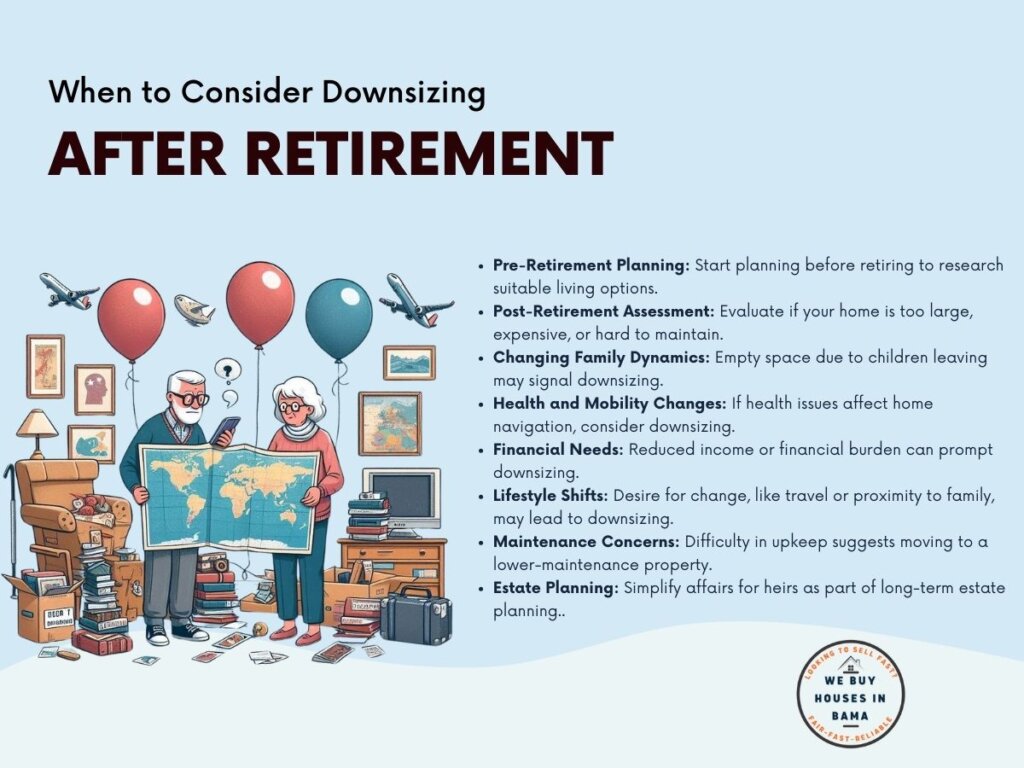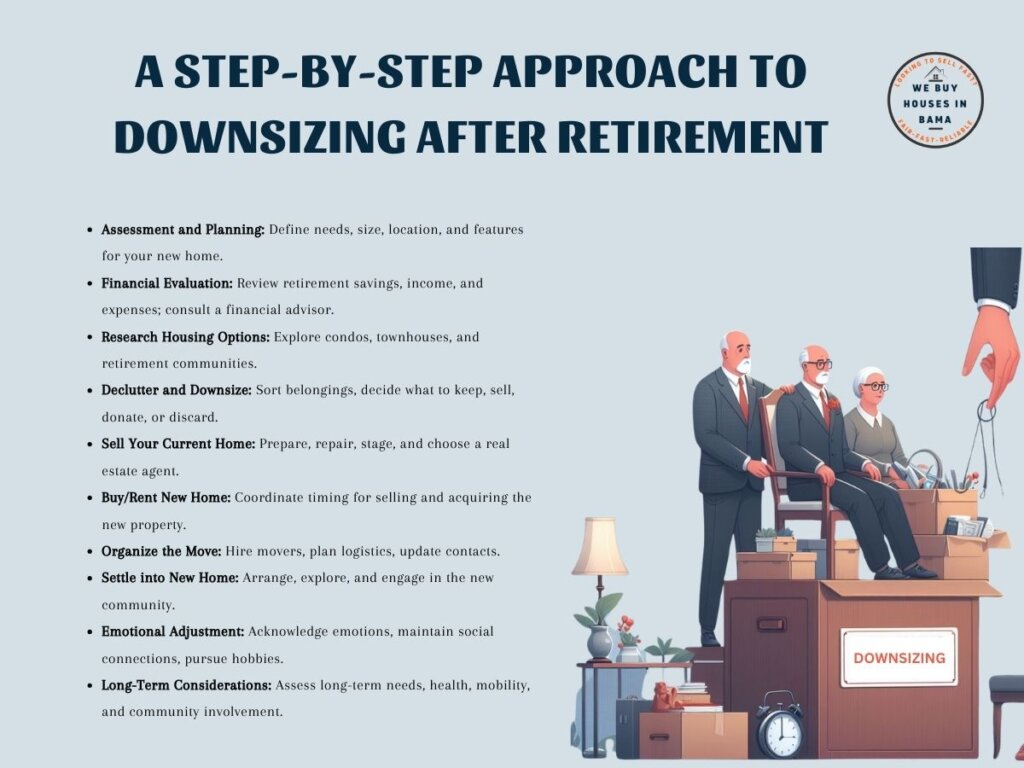Retirement marks a significant life transition filled with the promise of newfound freedom and leisure. For many, it’s an opportunity to reevaluate their living situation and consider downsizing. Join us and explore our guide on downsizing after retirement.
Downsizing after retirement is a decision that goes beyond just moving to a smaller home; it’s about crafting a lifestyle that aligns with your evolving needs and aspirations.
In this guide, we will explore the why, when, and how of downsizing in retirement, offering valuable insights and a step-by-step approach to help you make informed decisions and embark on this fulfilling journey toward a more manageable and enjoyable retirement.
Understanding the ‘Why’ of Downsizing
Understanding the ‘Why’ of Downsizing is crucial for anyone considering this significant lifestyle change, particularly as they approach or enter retirement. This section delves into the various reasons that prompt retirees to downsize, highlighting the benefits and underlying motivations that drive this decision.
- Embracing a Simpler Lifestyle
As people grow older, their preferences and requirements often shift towards simplicity. A large family home, which was once bustling with activity, may start to feel unnecessarily big and empty. Downsizing to a smaller residence can lead to a more manageable and less cluttered living environment.
This simplicity can bring peace of mind and reduce the daily stress associated with maintaining a larger property.
- Financial Advantages
One of the most compelling reasons for downsizing is the financial benefit. Selling a larger property can release significant equity, which can be crucial in supplementing retirement savings. Additionally, smaller homes typically incur lower utility bills, reduced property taxes, and lower insurance costs.
This financial relief can be a game-changer for retirees, providing them with more funds to enjoy their leisure years, travel, or invest in other interests.
- Health and Mobility Considerations
As individuals age, health and mobility issues become more prominent. A larger home with multiple levels and extensive maintenance requirements can become a challenge. Downsizing to a single-level home or a property with fewer maintenance needs can make daily life more comfortable and safer.
This shift can be especially important for those who experience mobility limitations or other age-related health concerns.
- Proximity to Services and Social Opportunities
Retirees often downsize to be closer to essential services, healthcare facilities, family members, or social activities. Being near community centers, parks, or cultural attractions can enrich their social life and provide easier access to necessary services.
This aspect is particularly important as it ties into the overall quality of life during retirement.
- Change in Family Dynamics
As children grow up and move out, the need for a large family home diminishes. This change in family dynamics often prompts the consideration of downsizing. A smaller home can better reflect the current needs of retirees, who no longer require extra bedrooms or extensive living spaces.
- Preparing for the Future
Downsizing can also be a proactive step in planning for future needs. It allows retirees to choose a living situation that can accommodate potential lifestyle changes, health issues, or care requirements as they age. This foresight can alleviate future stress and ensure a comfortable and suitable living environment in the long term.
In summary, the decision to downsize is influenced by a combination of practical, financial, health, and emotional factors. It’s a deeply personal choice that reflects the individual’s current needs, future aspirations, and desire for a lifestyle that is both manageable and fulfilling in their retirement years.
When to Consider Downsizing
When to consider downsizing is a crucial aspect of retirement planning. Here are key times and factors that might prompt this decision:

- Pre-Retirement Planning
It’s wise to start thinking about downsizing before retiring. This allows for ample time to plan, both financially and emotionally, and to research suitable living options.
- Post-Retirement Assessment
Once retired, evaluate your living situation. If the home feels too large, expensive, or challenging to maintain, it might be time to consider downsizing.
- Changing Family Dynamics
Often, the departure of children from the home leaves empty space and unused rooms. This changes can signal an appropriate time to move to a smaller, more practical space.
- Health and Mobility Changes
If health and mobility issues start affecting the ability to comfortably navigate and maintain your current home, downsizing to a more manageable property should be considered.
- Financial Needs
If financial circumstances change — like reduced income post-retirement — and maintaining a larger home becomes a financial burden, downsizing can offer significant relief.
- Lifestyle Shifts
A desire for a change in lifestyle, such as wanting to travel more, live in a different climate, or be closer to family or amenities, can prompt downsizing.
- Maintenance Concerns
Growing disinterest or difficulty in maintaining a large property garden or dealing with home repairs can be a sign that it’s time to move to a lower-maintenance living situation.
- Estate Planning
As part of long-term estate planning, some may choose to downsize to simplify their affairs, ensuring an easier transition for their heirs.
Each individual or couple will have unique circumstances and motivations. The decision to downsize should be based on personal needs, lifestyle preferences, and long-term plans, ensuring that the move aligns with overall retirement goals and well-being.
A Step-by-Step Approach to Downsizing
Downsizing in retirement can be a significant but rewarding transition. Here’s a step-by-step approach to make the process smoother and more efficient:

1. Assessment and Planning
Start by reflecting on your specific needs and goals for downsizing. Consider what you want in your new home in terms of size, location, and type.
Key aspects like accessibility, proximity to amenities, and community features should be a part of this planning phase. This initial assessment will guide all subsequent decisions in the downsizing process.
2. Financial Evaluation
Review your financial situation carefully. This includes understanding your retirement savings, current income, and ongoing expenses.
Calculate the potential proceeds from selling your current home and the cost involved in moving to a new one. It’s often beneficial to consult with a financial advisor for personalized advice to ensure that your move aligns with your financial goals.
3. Researching Housing Options
Explore different housing options such, as condos, townhouses, or retirement communities. Visiting potential neighborhoods and properties will give you a better sense of what’s available and what might suit your lifestyle.
Pay special attention to the amenities and services offered in these areas, especially those catering to retirees.
4. Decluttering and Downsizing Belongings
Begin the process of sorting through your belongings. Decide what to keep, sell, donate, or discard. Approach this task one room at a time to avoid feeling overwhelmed.
Also, consider the sentimental value of items, such as family heirlooms, and think about passing them on to family or friends.
5. Selling Your Current Home
Prepare your home for sale, which may involve minor repairs, upgrades, or staging. Select a reputable real estate agent with experience in your area to help you navigate the market.
Understanding current market conditions is crucial to pricing your home effectively.
6. Buying or Renting the New Home
Once your current home is on the market, begin the process of purchasing or renting your new home. Collaborate with a real estate agent who understands the specific needs of retirees.
Ensure the timing of selling your old home and acquiring the new one is well-coordinated.
7. Organizing the Move
Hire a reputable moving company, preferably one with experience in helping clients downsize. Plan the logistics of your move, including packing, transportation, and unpacking. Also, remember to update your address with utilities, the post office, and other important contacts.
8. Settling into Your New Home
Arrange your new home to make it comfortable and functional. Allow yourself time to get used to the new environment and explore your new community. Engaging in local activities and organizations can help you build a new social network and ease the transition.
9. Emotional Adjustment
Recognize and acknowledge the emotional aspects of leaving your old home and adjusting to the new one. Maintaining connections with your social circle is vital during this transition. Also, pursue new hobbies and interests to embrace this new chapter in your life.
10. Long-Term Considerations
Once you are settled, consider your long-term needs and how your new home accommodates them. Stay proactive about your health, mobility, and community involvement to ensure a fulfilling retirement life.
Emotional Considerations
Downsizing in retirement is an emotional process that involves more than just moving to a smaller home. It’s about letting go of a home filled with memories, which can be emotionally challenging, and adapting to a new environment and lifestyle.
This transition often stirs a mix of emotions, from apprehension about the unknown to excitement for new beginnings. It requires adjustments in social circles and personal identity. Open communication with family and seeking support from friends or professionals can be crucial.
Gradually, retirees adjust their expectations and embrace this new chapter, finding a balance between honoring their past and looking forward to their future.
Conclusion
Downsizing after retirement can open the door to a new phase of life filled with opportunities. While it involves significant planning and decision-making, the benefits of a simpler, more cost-effective, and convenient lifestyle can be immensely rewarding.
Downsizing is not just about moving to a smaller home; it’s about embracing a new chapter in life filled with opportunities and a more manageable way of living.
So, whether you’re looking to free up equity, enhance your quality of life, or adapt to changing circumstances, downsizing can be a positive and rewarding choice for your retirement years. With careful consideration and preparation, downsizing can be a positive and fulfilling experience.
